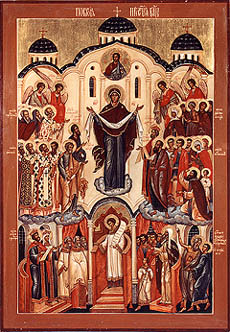Difference between revisions of "Protection of the Mother of God"
m (added icon) |
(add hymns) |
||
| Line 7: | Line 7: | ||
The Protection is commemorated most fervently in Slavic churches, probably because St. Andrei was a Slav. The first celebration of the Theotokos's cerement in the [[Church of Russia|Russian Orthodox Church]] dates back from the 12th century and today is celebrated throughout the Orthodox Church. | The Protection is commemorated most fervently in Slavic churches, probably because St. Andrei was a Slav. The first celebration of the Theotokos's cerement in the [[Church of Russia|Russian Orthodox Church]] dates back from the 12th century and today is celebrated throughout the Orthodox Church. | ||
| + | ==Hymns== | ||
| + | [[Troparion]] (Tone 4) | ||
| + | :Today the faithful celebrate the feast with joy | ||
| + | :illumined by your coming, O Mother of God. | ||
| + | :Beholding your pure image we fervently cry to you: | ||
| + | :"Encompass us beneath the precious veil of your protection; | ||
| + | :deliver us from every form of evil by entreating Christ, | ||
| + | :your Son and our God that He may save our souls." | ||
| + | |||
| + | [[Kontakion]] (Tone 3) | ||
| + | |||
| + | :Today the Virgin stands in the midst of the Church | ||
| + | :and with choirs of saints she invisibly prays to God for us. | ||
| + | :Angels and bishops worship, | ||
| + | :apostles and prophets rejoice together, | ||
| + | :since for our sake she prays to the pre-eternal God. | ||
==Sources and external links== | ==Sources and external links== | ||
* [http://www.mgr.org/TheVeil.html The Miracle of the Virgin Mary at the Church of Blachernae in Constantinople in 911 A.D.] | * [http://www.mgr.org/TheVeil.html The Miracle of the Virgin Mary at the Church of Blachernae in Constantinople in 911 A.D.] | ||
Revision as of 20:05, October 4, 2006
The Protection of the Mother of God is one of the most beloved feast days on the Orthodox calendar, especially among the Slavic peoples, commemorated on October 1. It is also known as Virgin Mary's Cerement. In most Slavic languages the word "cerement" has a dual meaning of "veil" and "protection."
The feast day celebrates the appearance of the Mother of God at Blachernae (Vlaherna) in the tenth century. At the end of St. Andrei (Andrew of Constantinople) Yurodivyi's life (d. around 936; feast day: October 2), a group of people saw the Mother of God, St. John the Baptist, and several other saints during a vigil in the Church of Blachernae, nearby the city gates.
The Theotokos approached the center of the church, knelt down and remained in prayer for a long time. Her face was drowned in tears. Then she took her veil (cerement) off and spread it over the people as a sign of protection. During the time, the people in the city were threatened by a barbarian invasion. After the appearance of the Mother of God, the danger was averted and the city was spared from bloodshed and suffering.
The Protection is commemorated most fervently in Slavic churches, probably because St. Andrei was a Slav. The first celebration of the Theotokos's cerement in the Russian Orthodox Church dates back from the 12th century and today is celebrated throughout the Orthodox Church.
Hymns
Troparion (Tone 4)
- Today the faithful celebrate the feast with joy
- illumined by your coming, O Mother of God.
- Beholding your pure image we fervently cry to you:
- "Encompass us beneath the precious veil of your protection;
- deliver us from every form of evil by entreating Christ,
- your Son and our God that He may save our souls."
Kontakion (Tone 3)
- Today the Virgin stands in the midst of the Church
- and with choirs of saints she invisibly prays to God for us.
- Angels and bishops worship,
- apostles and prophets rejoice together,
- since for our sake she prays to the pre-eternal God.
Sources and external links
- The Miracle of the Virgin Mary at the Church of Blachernae in Constantinople in 911 A.D.
- News item: Bulgarian Orthodox Church Celebrates Virgin Mary's Cerement Today (1 October 2005)
- The Protection of our Most Holy Lady the Mother of God and Ever-Virgin Mary (OCA)
- The Most Holy Theotokos of All Protection
- The Church of Panagia of Blachernae
